Congratulations to Biosis Healing R&D Center for its new achievements. The company's SIS hydrogel is used to accelerate chronic wound healing research article "Mechanically active small intestinal submucosa hydrogel for acceleratig chronic wound healing" was included in the authoritative journal "Journal of Materials Chemistry B" in the field of biomedical materials, with an impact factor of 7.571.
In this study, the researchers used SIS hydrogel as a bioactivity inducer, and for the first time demonstrated the role of SIS hydrogel in promoting angiogenesis and inducing the differentiation of macrophages towards anti-inflammatory, which can promote faster skin wounds in diabetic rats heal.
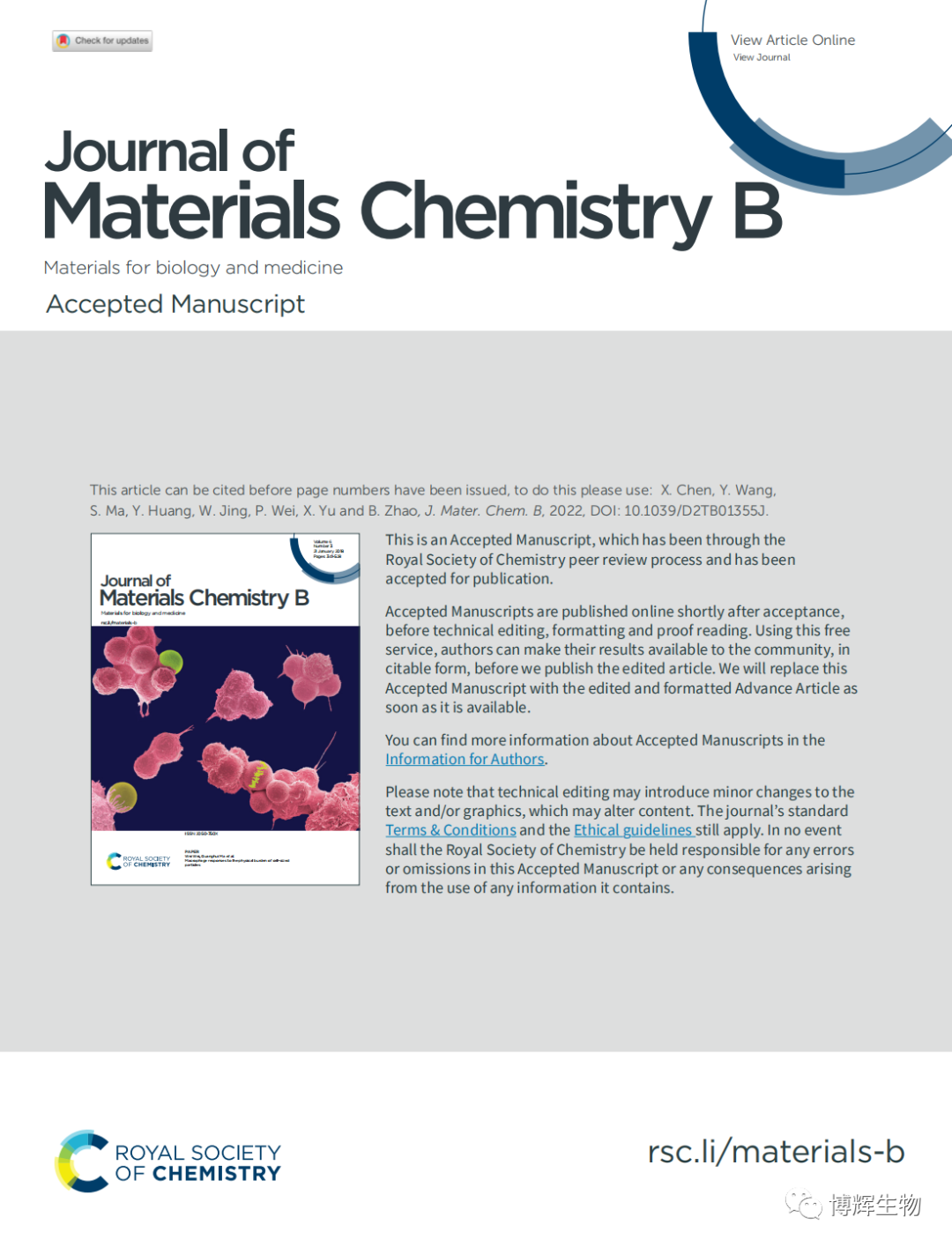
This research was completed by the team of Professor Zhao Bo, Yu Xueqiao, associate chief physician, Dr. Wei Pengfei from Biosis Healing, and Wang Yi, Associate professor, Renmin University of China, and the team of Dr. Ma Shiqing from Tianjin Medical University. The main research object is the SIS biological material with independent intellectual property rights of Biosis Healing.
SIS biomaterials are derived from animal small intestinal submucosa, mainly composed of various types of collagen, glycosaminoglycans, adhesion molecules and growth factors (such as transforming growth factor-β (TGF-β), basic fibroblast growth factor (bFGF) and vascular endothelial growth factor (VEGF), which play key roles in tissue regeneration. SIS has good biocompatibility, bioactivity, hydrophilicity, and low immunogenicity, and has been widely used in cell culture substrates, surgical patches, tissue engineering scaffolds, guided tissue regeneration membranes, and wound dressings.
Collagen molecules in SIS can self-assemble and condense into three-dimensional network hydrogels under 37°C, namely SIS hydrogels. Because the structure and bioactivity of SIS hydrogels can be fine-tuned for desired applications, they are widely used to promote regeneration of damaged tissues.
In this study, the researchers designed a novel SIS-based mechanically active hydrogel dressing (SIS-PNIPAm), which contains SIS and the thermoresponsive polymer PNIPAm. After adding the coupling agent, the SIS-PNIPAm hydrogel can effectively adhere to the skin and shrink spontaneously at body temperature. In addition, SIS-PNIPAm hydrogel has good biocompatibility, can promote angiogenesis, regulate macrophage polarization, and promote wound healing.

Figure: Schematic diagram of synthesis, mechanical activity, and biological activity (angiogenesis and immunomodulation) of SIS-PNIPAm hydrogels
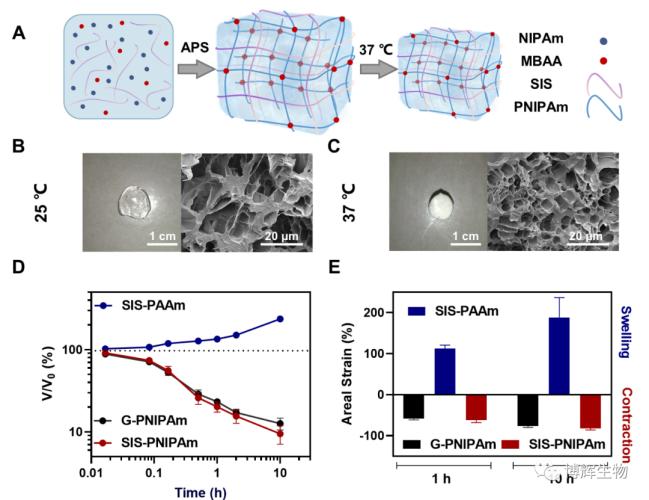
Figure: (A) Schematic synthesis of SIS-PNIPAm hydrogel; representative macroscopic and SEM images of SIS-PNIPAm hydrogel at (B) 25°C and (C) 37°C; (D) Volume change curves of various hydrogels measured under equilibrium conditions at 37°C and (E) area strain curves.
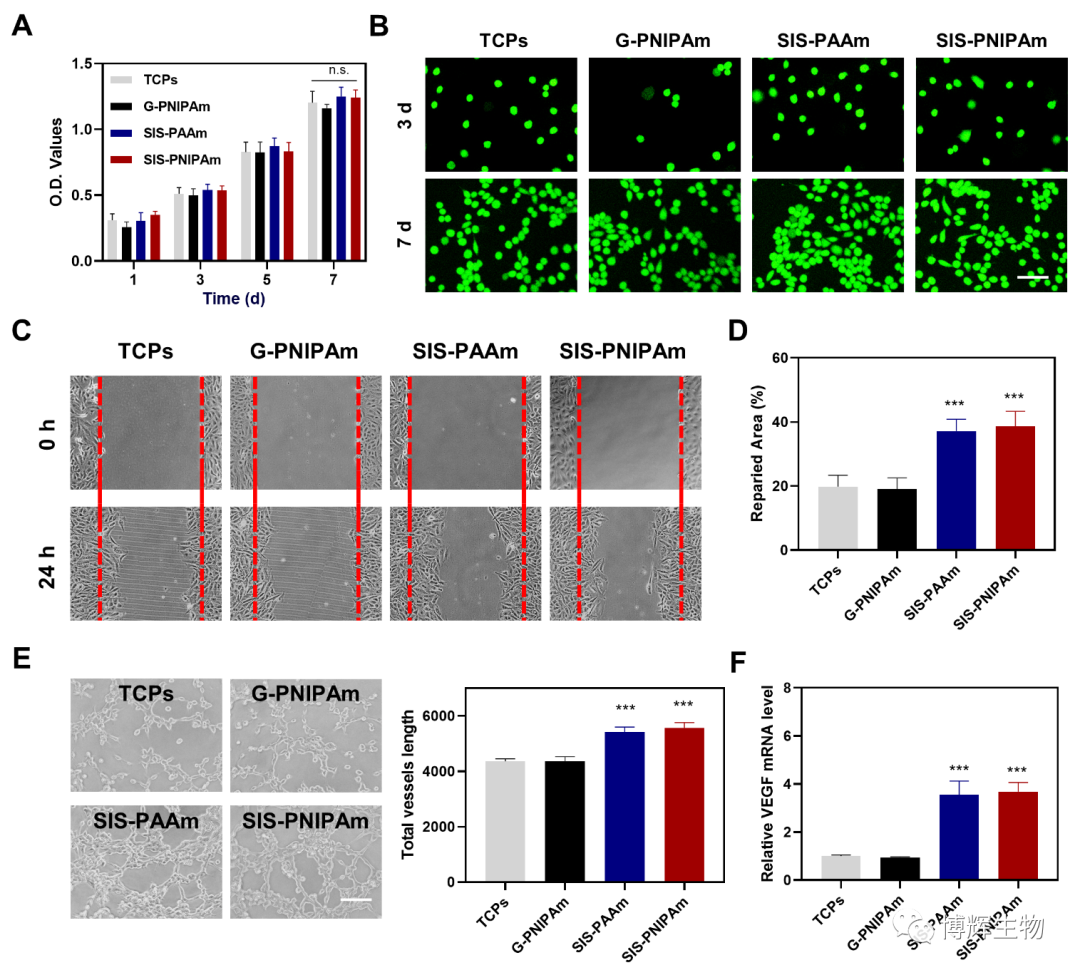
Figure: (A) proliferation and (B) live/dead staining of L929 cells treated with various hydrogel leaching solutions; (C) migration of HUVECs in different leaching solutions and (D) Quantitative analysis of corresponding repaired areas; (E) Quantitative analysis of HUVECs in vitro tubule formation and corresponding total tubule length in ; (F) RT-qPCR analysis of VEGF gene expression in HUVECs. Scale bar = 200μm.
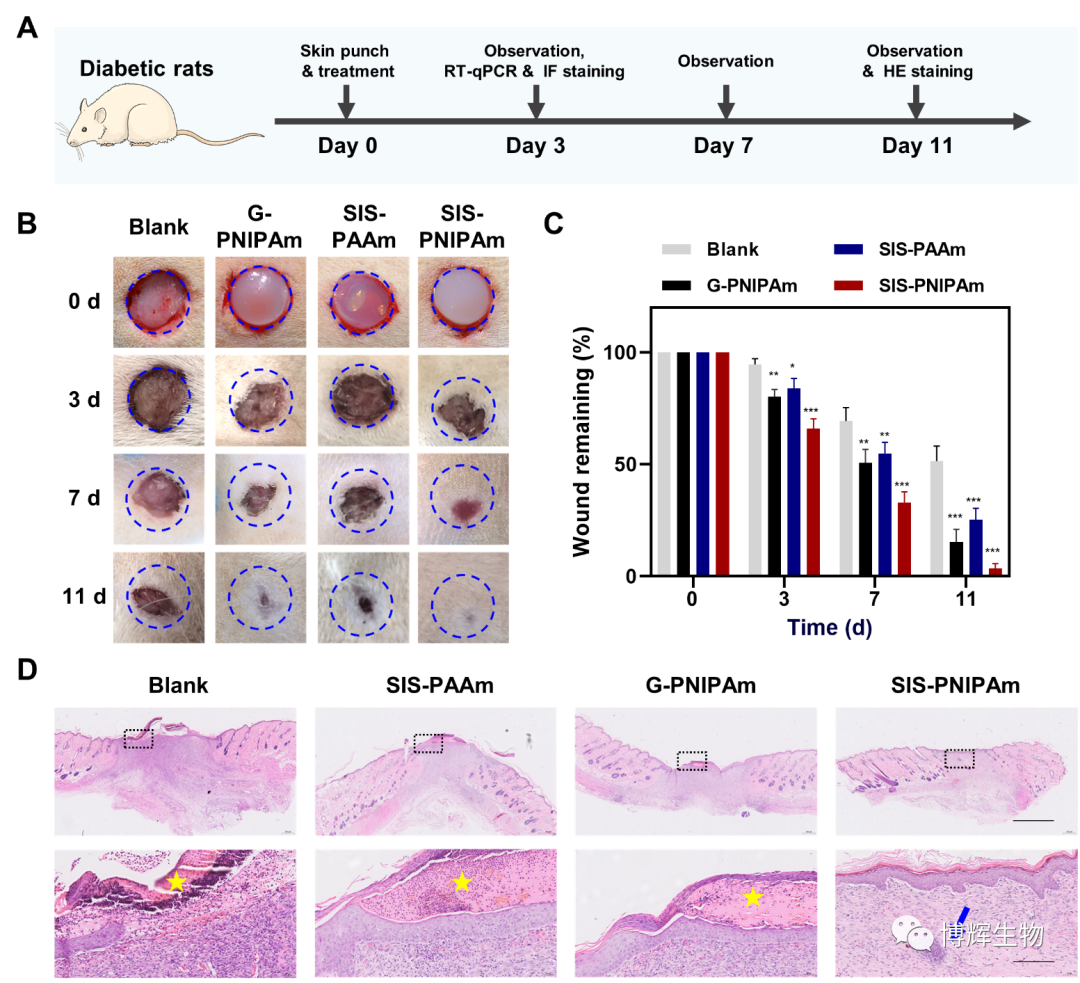
Figure: (A) Schematic diagram of the full-thickness wound model in diabetic rats; (B) Macroscopic images of wound healing and (C) percentage of remaining wounds within 11 days; (D) H&E staining of wound sections on day 11. Yellow stars indicate remaining scars, blue arrows indicate regenerated hair follicles, scale bar is 500 μm.

Pictured: (A) Wound tissue used for RT-qPCR on day 3; RT-qPCR analysis of (B) VEGF, (C) TGF-β, (D) IL-1β, (E) IL-6, (F) IL-4, (G) L-10 gene expression; (H) immunofluorescence images of skin wound tissue nuclei (blue), F4/80 (green) and CD163 (red). Scale bar = 200 μm.
Conclusion
In this study, researchers designed a novel bioactive and mechanically active hydrogel dressing, SIS-PNIPAm, that effectively adhered to the skin and spontaneously contracted skin wounds at body temperature. SIS-PNIPAm hydrogel has good biocompatibility, promotion of angiogenesis and immune regulation. In vivo evaluation of SIS-PNIPAm hydrogel on a diabetic rat full-thickness wound model showed that the wound healing process was significantly accelerated in the absence of any drugs and growth factors.
We believe that SIS-PNIPAm hydrogel with mechanical activity and bioactive will be an ideal candidate for chronic wound healing.
【Introduction of author】
Zhao Bo
Biosis Healing founder, doctor of surgery
Professor-level senior engineer/ associate chief physician/ graduate supervisor/ postdoctoral supervisor
As the main completion and project leader, he has undertaken and completed four projects of National Natural Science Foundation of China, Beijing Natural Science Foundation and many scientific research projects.
Yu Xueqiao
CMO, doctor of surgery, associate chief physician, engaged in clinical practice of gastrointestinal surgery for more than 10 years
Participated in and completed three projects of the National Natural Science Foundation of China, presided over one of the Natural Science Foundation of Hubei Province and one of the scientific research projects of the Hubei Provincial Health Commission, and published more than 20 papers in professional journals at home and abroad as the first author or corresponding author.
Wang Yi
Associate Professor of Renmin University of China, Master Supervisor, Doctor of Sports Medicine
Engaged in empirical research in sports medicine for many years
Presided over 1 project funded by China's manned spaceflight project, 1 project from the National Social Science Fund, and 1 project from the State Sports General Administration. The research and development achievements have won the China Patent Excellence Award for many times.
Ma Shiqing
Department of Stomatology, Second Hospital of Tianjin Medical University, Lecturer, Attending Doctor
oung committee of the Professional Committee of General Oral of the Chinese Stomatological Association
Research direction is guided tissue regeneration and implant surface modification Presided over 1 youth project of the National Natural Science Foundation of China In the past 5 years, he has published 5 SCI papers as the first author and 1 SCI paper as the corresponding author, with a cumulative impact factor of 58.46
Won the second prize of Tianjin Science and Technology Progress Award
131 Third-level Talents in Tianjin
Candidates for the "Young Reserve Talents Support Program" in Tianjin Universities
Outstanding Teacher of Tianjin Medical University
Wei Pengfei
Beijing Biosis Healing Biotechnology Co., Ltd. Post-doctoral
Doctor of Biomedical Materials, Beijing University of Chemical Technology
Supported by the 68th batch of China Postdoctoral Science Foundation
2020 Annual Postdoctoral International Exchange Program Academic Exchange Project





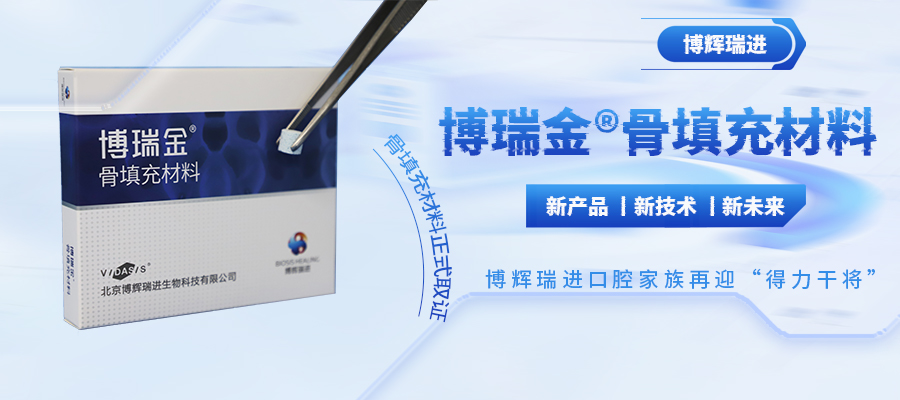
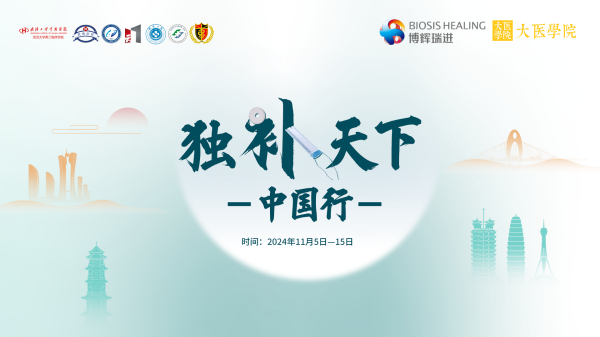




版权所有®2019BIOSISHEALING